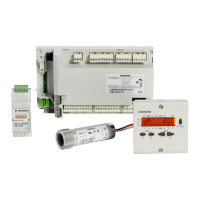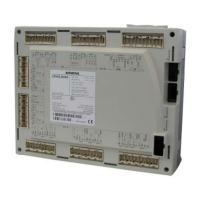47/213
Building Technologies Basic documentation LMV37.4... CC1P7546en
HVAC Products 6 Basic unit 01.12.2009
6.5.2 Valve proving
Valve proving is only active when firing on gas. This is a valve proving designed to de-
tect leaking gas valves and, if necessary, to prevent the valves from opening or ignition
from being switched on. Lockout is initiated.
When performing valve proving, the gas valve on the burner side is opened first to bring
the test space to atmospheric pressure. After closing the valve, the pressure in the test
space must not exceed a certain level. Then, the gas valve on the mains side is opened
to fill the gas pipe. After closing the valve, the gas pressure must not fall below a certain
level.
Valve proving can be parameterized to take place on startup, shutdown, or on both.
The type of valve proving can be selected via parameter 236.
Recommendation:
Perform valve proving on shutdown.
No. Parameter
236
Gas: Pressure switch-min input
0 = inactive
1 = pressure switch-min (before fuel valve 1 (V1))
2 = valve proving via pressure switch-min (between fuel valve 1 (V1) and fuel
valve 2 (V2))
241
Gas: Execution valve proving
0 = no valve proving
1 = valve proving on startup
2 = valve proving on shutdown
3 = valve proving on startup and shutdown
242 Gas: Valve proving evacuation time
243 Gas: Valve proving time atmospheric pressure
244 Gas: Valve proving filling time
245 Gas: Valve proving time gas pressure
Caution!
If valve proving is parameterized to take place «on startup and shutdown», the
gas valves must run through additional switching cycles. As a result, strain on
the gas valves (wear) increases.
Caution!
The OEM must set the evacuation, filling and test times for atmospheric or
mains pressure on every plant in compliance with the requirements of EN 1643.

